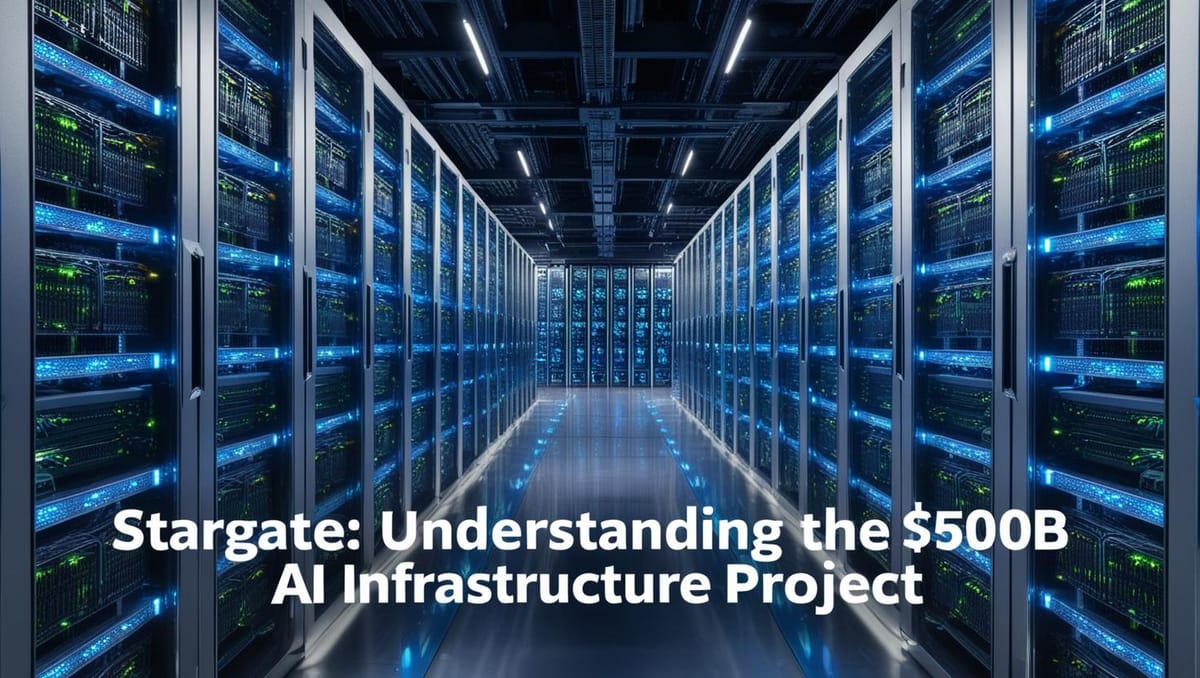Stargate: Understanding the $500B AI Infrastructure Project

The tech world is buzzing with news of Stargate, a massive $500B collaboration between several tech giants aimed at building AI infrastructure across the United States. The announcement was notably vague, stating only that "Starting immediately Stargate will be building the physical and virtual infrastructure to power the next generation of advancements in AI and this will include the construction of colossal datacenters and physical campuses across the country."
Let's decode what this really means.
The Foundation: Understanding Modern AI
Before we dive into Stargate's implications, let's establish a quick foundation. AI today is essentially specialized software that learns from vast amounts of examples – whether that's text, images, audio, or video. After processing this information, it can recognize patterns it's seen before and make educated guesses about new situations.
Think of it like human learning: show someone enough pictures of dogs, and they'll reliably identify dogs they've never seen before. This current state of AI is called Artificial Narrow Intelligence (ANI), and it's what powers everything from ChatGPT to automated medical imaging analysis.
The Next Phase: Artificial General Intelligence (AGI)
Recently, industry leaders like Sam Altman (OpenAI's CEO) and Masayoshi Son (SoftBank's CEO) have been discussing the next evolution: Artificial General Intelligence. Using our earlier example, while current AI might just recognize "that's a dog," AGI would understand broader concepts: "that's a dog, it's moving, and gravity is keeping it on the ground." AGI wouldn't just focus on single tasks – it would understand and reason about the world more holistically, similar to human intelligence.
Where We Stand Today
Some argue we're seeing early signs of AGI capabilities. In December, OpenAI's (o3) model achieved an impressive 87.5% score on the ARC AGI Benchmark – an industry standard using tests that don't exist on the internet, requiring genuine reasoning rather than pattern matching. The model also outperformed most humans in competitive programming, competition-math, and PhD-level science questions.
Enter Stargate: Beyond Data Storage
This brings us to Stargate's role. As AI models consume available training data, we need both new data sources and more computing power. While many assume Stargate's data centers are primarily for storage, they're actually focused on data processing – providing the computational power needed for advanced AI models.
Understanding Compute Power
Think of compute power like a game of flashcards. With low compute, it's like being shown a picture and having to immediately call out what you see – there's no time to process or think deeply about the image. But with more compute power, it's like having both extra time to analyze the picture and additional team members to help make the decision. In the AI world, this thinking process is called "inference."
This is why compute power is so crucial for AI development. As OpenAI's Chief Product Officer Kevin Weil told the WSJ: "More compute leads to better models." The statement reflects a crucial insight: we've reached a point where simply adding more training data isn't providing the gains it used to. Instead, the focus has shifted to processing power. As Weil clarified, these new data centers will "house GPUs that will train models and run inference that support AI products" – in other words, they're adding massive amounts of compute power to enhance AI's ability to think and reason.
The Real-World Data Challenge
Perhaps more intriguingly, these advanced models will need significant amounts of "real world" data that currently doesn't exist. This points to an emerging trend: expect to see an increase in very low-cost wearables and smart devices that enhance existing tools while acting as data collectors. The business model will shift – device manufacturers may sell at near-cost, with the real value lying in the data they collect.
Why This Matters: AI's Current Impact
The significance of Stargate becomes clearer when we look at AI's current impact across industries:
Healthcare
- AI systems are detecting tumors earlier than human doctors
- AI accelerates drug discovery by analyzing molecular and protein databases
Technology
- NVIDIA has leveraged AI to create more powerful chips at lower costs
- Development and testing cycles are being dramatically shortened
Energy Management
- Smart buildings use AI to optimize energy usage based on occupancy and environmental factors
- Real-time adjustments reduce waste and lower energy consumption
Looking Forward
Whatever your stance on AI – enthusiastic, cautious, or skeptical – it's clear that Stargate represents a significant milestone in technological infrastructure. The project signals both the tech industry's confidence in AI's future and the massive computational requirements needed to achieve it.
I'll continue monitoring these developments and sharing insights about their practical implications. Follow along here on Above Curve, or connect with me on X and LinkedIn for regular updates on how emerging technologies are reshaping our world.
Paul Laird has been researching and working with AI since 2019, focusing on making complex technological advances accessible and practical for businesses and individuals alike.




